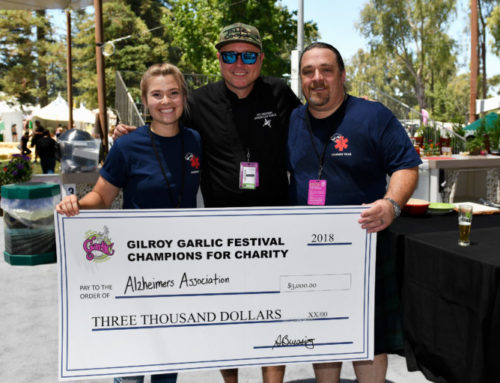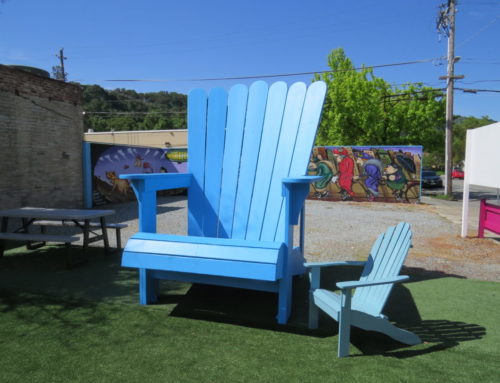By Marty Cheek
Longtime Gilroy resident Connie Rogers has a passion for local history. The president of the Gilroy Historical Society often takes groups on free walking tours through the downtown and other areas of the city to explore the historic buildings, cemeteries and other locations serving as reminders that Gilroy is blessed with a fascinating backstory.
“Local history has always been an interest in mine,” Rogers said. “Being from New England people seem to be more conscious of their history — and they save their buildings! They don’t tear them down. I think in that sense, I kind of came by it from my background.”
The number of people who show up for the tours, which are scheduled for the first Saturday of each month from 10 a.m. to noon, can vary greatly. But Rogers remains dedicated to the program. Sometimes no one comes and sometimes there are more than 20 tour takers.
Roger’s own personal history starts in Vermont where she grew up and married Jim Rogers in 1963. They met at the University of Vermont, also known as one of the public ivy’s, where she was earning a bachelors degree in home economics. Jim graduated two years before she did. He had been in the college’s ROTC program to help pay his way through school and so was sent to an Air Force base in central Washington state. Rogers wanted to put her college degree to use and went to the employment office. She was offered a position as a social worker for a county welfare office — and soon found herself enjoying a career.
The couple lived on the Air Force base for a year and then Jim left the service upon completing his obligations. He wanted to get his teaching credentials and decided to attend San Jose State University.
“We had a little red Volkswagen and a cat and very few belongings. So we put everything in the little red Volkswagen and started down the coast,” she recalled those early years. “We ended up in San Jose, which was already too big for us at 264,000 people.”
For a year and a half Rogers worked as a social worker for Santa Cruz County. After earning his credentials at SJSU, Jim found a job teaching at Brownell Elementary School and the couple moved to Gilroy in 1966. They immediately fell in love with the small, friendly farming community. As Jim spent time in the classroom, Rogers continued her career for Santa Clara County as a social worker based in San Martin office. She worked there for the next 10 years.
During that time, two boys came into their lives — Andrew and Brian — who became the darlings of the couple’s lives. Andrew now is a second grade teacher at the private Stevenson Elementary School in Carmel and Brian lives with his parents.
With their children in elementary schools in the 1970s, Rogers found herself moving into leadership positions in Gilroy’s education community. She served as the president of the Las Madres Club, followed by a role as the president of the parents club at El Robles Elementary Schoo. She also found herself as the president in 1975 of the Gilroy Branch of the American Association of University Women. In the 1980s, she was appointed to the Parks and Recreation Commission and found she liked that role.
“I learned a lot from Bill Aire who was the parks director at the time,” she said. “He was a very sharp man.”
Her leadership experience in the PRC helped her get appointed to Gilroy’s Planning Commission when another commissioner left. She quickly learned how contentious the commission could be when dealing with sensitive community issues. At her first meeting she had to decide what location to put Gilroy’s new hospital (now Saint Louise Regional). The final outcome was to put it just east of U.S. 101, but many people in the community felt it was a difficult location to get to and preferred a more central location.
From the Planning Commission, Rogers found her way to a seat on the Gilroy City Council when in 1993 she ran for office against nine other candidates vying for three available seats. She got on the city council and found it was “really a steep learning curve” deciding upon tough city business and financial issues. Helping her and the other council members was City Administrator Jay Baksa.
“He would always remind us that leadership is always a matter of your priorities,” she recalled. “If you take from this area to put in that area, you know, there’s only so much money to go around. I thought he was a wonderful manager, although we didn’t always agree. He always gave the city council choices and would say you can do A or B or C and this is what is likely to happen in each scenario.”
In the fall of 1997 Rogers even served for the entire month of September as Gilroy’s mayor. County supervisor Mike Honda left the board when he got elected to the assembly and then Don Gage got elected to fill Honda’s space.
“There we were, there were six of us on the council left, and no mayor because Don had been our mayor then,” Rogers said. “We could have appointed somebody but the time between March and November is pretty short. We were of varying political stripes, but we got along well enough to say let’s take turns, we can do this for six months. We sort of had ‘Mayor of the month.”
That year, she also ran for re-election and lost the race that November over the issue of whether or not to require the Gilroy Public Library to install information filters on the computers available for patrons. At that time, a contingent of parents feared their children and other people’s children might access pornography on the library computers. They formed a group called “KIDS” (Keep the Internet Decent and Safe) and one of their members, Cynthia Walker, ran for city council on that platform.
“They were all over town. They had buttons that said, ‘NO PORN’ and so I happened to run into Cynthia Walker in the coffee shop and I asked, ‘Can I have a button, too?’” Rogers said. “My position at the time was that this is not just a Gilroy problem, this is a nationwide thing that has to be discussed and talked about. And re-eningeering the whole computer system in the library is very expensive if you’re not sure how effective it’s going to be.”
Walker had a regular column in the Gilroy Dispatch. The Friday before the election, the headline on her column read: “A vote for Connie is a vote for net porn.”
Rogers was shocked at this misstatement. “That was terrible. It was too late to rebut it. I think it was more hysteria by the press and the public.”
Rogers lost the election. But that opened up the door to her spending time on her passion for local history. She soon joined the Gilroy Historical Society at the suggestion of a friend. Her leadership skills learned over the years served her well as the president of the society, a role she enjoys.
“From my background in Vermont, I learned that people in a small town know that they’re interdependent,” she said of why she stays involved. “They know that everybody has to pitch in and help to make things happen. And that is kind of where I’m coming from. My other goal is to raise the profile of local history.”






